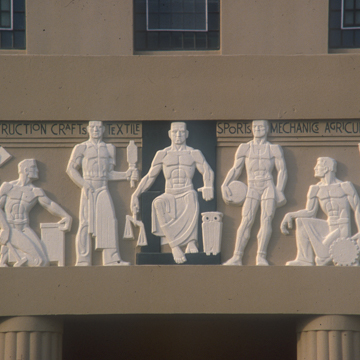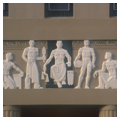When completed in 1936, the state prison at Reidsville in Tattnall County was considered a model prison, intended as a replacement for the convict camps for which Georgia had been criticized nationally. Built with Public Works Administration funds under the supervision of the Prison Commission of Georgia, it cost $1.5 million, including equipment, and was a 70/30 cost sharing enterprise between the state and the federal government. It was the first prison to receive accreditation for meeting requirements set forth by the American Correctional Association for Adult Correctional Facilities.
The prison edifice is designed in the stripped classical or “depression modern” style, also evident in Atlanta’s Federal Post Office Annex completed in 1933, and standard for government offices built around the State Capitol from the 1930s through the 1950s. Here the concrete building is reductive, but monumental in character, and Tucker and Howell have produced a dignified institutional landmark in a lonely landscape. Visitors traveling on the rural road south out of Reidsville come suddenly upon the massive building. The main facade is 1,020 feet wide and the building extends back 842 feet. It is capped by a broad central cupola with a lantern; in front is a freestanding guard tower that resembles an airport control tower. When combined with ample use of razor wire, the tower adds to the overall formidable character of the prison complex.
Behind the tower and entry building, the complex contains eight cellblock units that were originally segregated, with white prisoners on the right side and black prisoners on the left. Additional buildings were added over the years; the prison was renovated in 1979. Originally projected to house 2,000 prisoners, the capacity is now just over 1,300 inmates, who reside in single cells within eleven buildings, each containing four two-tiered cell blocks.
The more humane side of prison life is suggested by Julian Harris’s Rehabilitation sculptural frieze, positioned over the entry just beyond the guard gate. Harris’s figural sculpture adorned schools, banks, government buildings, and institutional structures from the 1930s to the 1950s, and often represented professional and trade subjects. Here, the frieze focuses on labor, recreation, and work ethic. At the center of the composition a muscular male figure sits enthroned; holding scales; he replaces the traditional female symbol of justice. To the viewer’s left are figures representing construction, the crafts, and textiles; on the right side of the lintel are sports, mechanics, and agriculture, each figure holding an emblem of its trade or activity. Justice and the two figures flanking him are depicted frontally, the end figures are shown in profile looking toward Justice at the center. The kneeling figures between them are also in profile. The whole composition is balanced and symmetrical demonstrating Harris’s mastery of human proportions and stylized musculature. The message of the frieze was clear and hopeful—through hard work and dedication prisoners could be rehabilitated.
This prison is located in an isolated part of the state, south of the interstate connecting Macon and Savannah (I-16), on a barren stretch of highway with only a few distinctly rural crossroads. Away from urban centers and any direct industrial support, the prison at Reidsville was designed to be self-sufficient. A 980-acre tract of land surrounds the prison and includes a farm where prisoners originally cultivated their own food. They also learned trades in prison machine shops, maintained spare parts for prison equipment in storage units, operated the state’s automobile tag plant, and played sports in two large recreational fields.
During the 1930s, inmates at Reidsville ranged from young boys to some of the most dangerous men in the state. For a time, Georgia State Prison was the state’s death row prison and the site of executions by electrocution. Today, it is a maximum-security facility housing some of the most aggressive male adult offenders in Georgia. A decidedly non-aggressive male prisoner was sent here in October 1960. Because of a violated probate traffic sentence, when Reverend Martin Luther King, Jr. was arrested in Atlanta during a lunch counter sit-in, he was sentenced to four months in prison. King was sent to Reidsville to serve his sentence, but was released on a $2,000 bond a week later after President John F. Kennedy expressed concern for his safety.

















